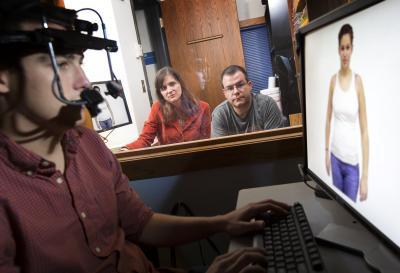Women can tell when someone's eyes aren't on her face and are instead looking at her body - because it happens all of the time. Men do it ... and so do other women. At least when they are in college.
The oft-rumored "objectifying gaze" is not just anecdotal evidence, say psychologists who set out to document the nature of roving eyes when it came to women's bodies. A new study employed eyetracking technology to map the visual behavior of college aged men and women as they viewed images of different females with different body types.
When asked to focus on a woman's appearance, study participants largely moved their eyes to and then dwelled on a woman's breasts and other sexualized body parts. Men exhibited such visual behavior consistently - so did women. However, male participants regarded the curvaceous women more positively than women with fewer curves, whereas female participants viewed these women similarly.
Yes, men are less critical of women than other women are.

Sarah J. Gervais, Assistant Professor of Psychology and Women's Studies and Mike Dodd, Associate Professor of Psychology, watch as graduate student Gerald McDonnell demonstrates the eye track hardware and software used for the research. Photo by Craig Chandler / University Communications, University of Nebraska-Lincoln
The researchers outfitted 65 college students with an eyetracking device and asked them to look at 30 photos of 10 college-aged women and to either rate the appearance or personality of the female in each picture. Each original image was manipulated to enhance or decrease the woman's sexualized body parts in an attempt to determine whether specific body types were more or less likely to be objectified.
Though the results were consistent with anecdotal expectations of gaze behavior, University of Nebraska-Lincoln psychologist Sarah Gervais said she was surprised with some of the findings, especially how strongly women's visual patterns suggest they objectify other women. "We do have a slightly different pattern for men than women, but when we looked at their overall dwell times – how long they focused on each body part – we find the exact same effects for both groups. Women, we think, do it often for social comparison purposes."
Whereas men were fast to fixate on both the bodies and faces of female targets, women in some circumstances were more likely to focus more quickly on faces.
Another key finding related to the role of body shape. Even when study instructions encouraged the participants to focus on the personality of the female target – a manipulation that would seem likely to lead to additional focus on the images' faces – women with hourglass figures were perceived more positively than women with straighter figures by male participants, the researchers found.
Objectifying gazes, of course, can have negative consequences: Prior research shows that when women are objectified, they are perceived to be less friendly, not as intelligent or competent or less moral. That women are doing it to women means some battle lines in the culture war would have to be redrawn a little.
"It can undermine (women's) work performance. It can cause them to self-silence and it's related to increased perceptions of sexual harassment," Gervais said. "If you think about all of the negative consequences, figuring out what's triggering all of those consequences, that's the first step toward stopping it from happening."
Co-author Michael Dodd said the experiment's use of both personality- and appearance-focused groups shows that the behavior can be changed with self-awareness.
"By characterizing the manner in which people fixate on the body when engaging in objectifying behavior, it also becomes possible to determine methods of reducing this behavior. That's what the personality manipulation part of the study did – that's a huge positive," Dodd said. "It's not as though looking at the body of someone has to be, or is, a default behavior. It just may be the case that cognitive control is required to engage in more appropriate, and less damaging, visual behavior."
Citation: Sarah J. Gervais, Arianne M. Holland, Michael D. Dodd, 'My Eyes Are Up Here: The Nature of the Objectifying Gaze Toward Women', Sex Roles October 2013 DOI: 10.1007/s11199-013-0316-x





Comments